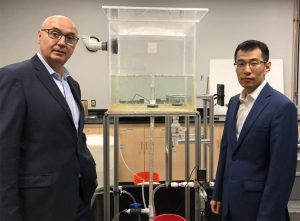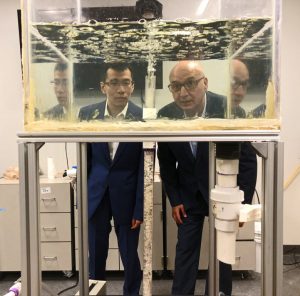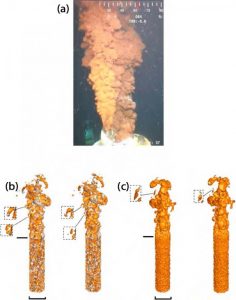Study Is First to Examine How Oil and Gas Tumbling Inside Pipe Affects Released Oil Estimations
– OCTOBER 17, 2018
Scientists analyzed visual observations and computer simulations of the Deepwater Horizon oil flow to better understand the characteristics of an uncontrolled pipeline flow and how they affect the amount of oil discharge and droplet size distribution, which are critical for effective response decisions. The study suggests that spill’s plume was likely not from a bubbly flow but rather from a more dynamic churn where oil and gas tumble within the pipe. Compared with a bubbly flow, a churn flow could potentially produce five times the energy loss in the pipe, and its plume could entrain 35% more water. Not accounting for this larger energy dissipation caused by a churn flow could result in an overestimation of discharged oil, perhaps by more than 200%. The significant implications of churn versus bubbly flow demonstrates the need to evaluate both types when assessing subsea blowouts.
The researchers published their findings in Geophysical Research Letters: Was the Deepwater Horizon well discharge churn flow? Implications on the estimation of the oil discharge and droplet size distribution.
The petroleum industry pumps crude oil out of below-seafloor geological reservoirs through pipelines so that it can ultimately be refined for end users. A controlled pipeline flow can range from streamlined to stratified to turbulent. Complicating the oil flow is its multiphase nature, where gas, additives, methane hydrates, and other gases and condensates can also be transported. During Deepwater Horizon, various groups implemented formidable efforts to estimate the oil flow rate, and all but one estimate assumed a bubbly flow. However, the video of oil coming out from the riser (provided by the Natural Resource Damage Assessment) suggested a behavior closer to churn, which has a more dynamic flow with significantly different hydrodynamics than a bubbly flow.
Study author Michel Boufadel explained why we need to understand how oil and gas moved within the pipe, “Based on the Oil Pollution Act of 1990, the responsible party is fined based on the amount of oil released into the water. Determining whether the flow is churn or not churn affects the estimation of the oil flow rate and droplet size distribution. A faster flow rate would cause larger damage to the environment than a slower rate, and the size of an oil droplet determines where it goes. Large droplets float directly to the surface, while small ones could be carried sideways (i.e., horizontally) by currents. Also, the smaller the droplet, the faster it degrades in water.”
Using high-resolution computer simulations that were run on a 64-computer cluster, this study’s researchers used large eddy simulations and oil and gas properties measured at the wellhead to simulate the three-phase system (oil, gas, and water) and characterize resulting oil plumes under both flows. They validated their numerical approach using a one-inch pipe and Particle Image Velocimetery to measure the velocities, which were found to be close to observations.
Compared with bubbly flow simulations, churn flow simulations more closely resembled the Deepwater Horizon plume in appearance. The churn flow plume interacted more with the surrounding water and exhibited a rapid reduction of oil fraction in the plume and large velocity at the plume’s edge, which is consistent with increased water entrainment. Determining the resulting droplet size distribution of churn flow was outside of the study’s scope. However, the authors suggested that its droplets would likely be smaller than those formed by a bubbly flow because the churn flow concentrated the oil in the plume’s center.
The authors’ calculations were based on a smooth pipe, and they acknowledged that protrusions in the Deepwater Horizon pipe were documented and are likely to exist in future blowouts. Small protrusions (metal fragments and spikes) could minimize churn flow behavior; however, more bulky protrusions (drill fragments that block portions of the pipe) could magnify churn flow.
The team recommended that future studies consider additional complexities such as pipe shape, hydrates, condensates, produced water, and additives used in production activities. They also recommended that future studies identify key measurements needed to confirm flow character for a range of conditions, which would decrease uncertainty and provide a more robust estimated flow rate.
Data are publicly available through the Gulf of Mexico Research Initiative Information & Data Cooperative (GRIIDC) at doi:10.7266/N7Q23XS7.
The study’s authors are Michel C. Boufadel, Feng Gao, Lin Zhao, Tamay Ozgokmen, Richard Miller, Thomas King, Brian Robinson, Kenneth Lee, and Ira Leifer.
By Nilde Maggie Dannreuther and Stephanie Ellis. Contact maggied@ngi.msstate.edu with questions or comments.
************
This research was made possible in part by a grant from the Gulf of Mexico Research Initiative (GoMRI) to the Consortium for Advanced Research on Transport of Hydrocarbon in the Environment II (CARTHE II). Other funding sources included the Department of Fisheries and Ocean Canada.
The Gulf of Mexico Research Initiative (GoMRI) is a 10-year independent research program established to study the effect, and the potential associated impact, of hydrocarbon releases on the environment and public health, as well as to develop improved spill mitigation, oil detection, characterization and remediation technologies. An independent and academic 20-member Research Board makes the funding and research direction decisions to ensure the intellectual quality, effectiveness and academic independence of the GoMRI research. All research data, findings and publications will be made publicly available. The program was established through a $500 million financial commitment from BP. For more information, visit https://gulfresearchinitiative.org/.
© Copyright 2010-2018 Gulf of Mexico Research Initiative (GoMRI) – All Rights Reserved. Redistribution is encouraged with acknowledgement to the Gulf of Mexico Research Initiative (GoMRI). Please credit images and/or videos as done in each article. Questions? Contact web-content editor Nilde “Maggie” Dannreuther, Northern Gulf Institute, Mississippi State University (maggied@ngi.msstate.edu).








